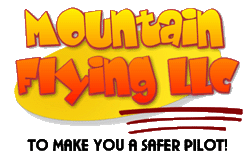FLYING CANYONS
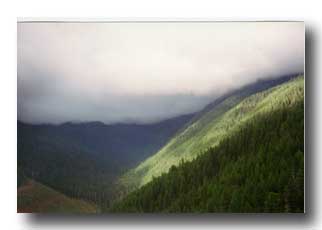
Recalling an afternoon flight from Billings, Mont. to Jackson, Wyo.
during the fall of 1968, I found myself, as the novice pilot,
positioning my airplane in the middle of canyons for what I
considered good reason ... staying away from those scary old canyon
walls.
This was when I first discovered that flying in the center of a canyon places the airplane is a poor position to turn around and backtrack to avoid some scattered thunderstorms passing through the canyon area.
FLY THE SIDE OF A CANYON
I later learned there is not one, but two compelling reasons to avoid flying the center of the canyon.
First, if the canyon narrows, the terrain out climbs the airplane, or if the weather provides an impelling reason to skedaddle out of the area, there is only half the canyon width available for a turnaround maneuver.
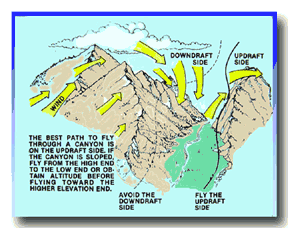
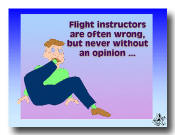 Second,
the center of a canyon is the area where shear will be found. Air
flowing down the lee side and up the windward side of a canyon
creates turbulence. Depending on the stability of the air, or lack
of stability, there is often found an area that lacks any type of a
meteorological emulsifier to mix the air; rather the air sets up an
eddy current that creates shear. When the wind is strong it's
definitely a good idea to avoid this area.
Second,
the center of a canyon is the area where shear will be found. Air
flowing down the lee side and up the windward side of a canyon
creates turbulence. Depending on the stability of the air, or lack
of stability, there is often found an area that lacks any type of a
meteorological emulsifier to mix the air; rather the air sets up an
eddy current that creates shear. When the wind is strong it's
definitely a good idea to avoid this area.
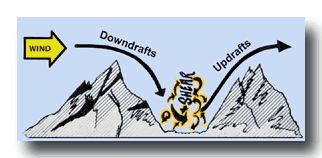 If
you have a choice when flying through a canyon, fly the upwind side.
It provides a better ride and there is no compromise with aircraft
performance degradation due to downdrafts and turbulence.
If
you have a choice when flying through a canyon, fly the upwind side.
It provides a better ride and there is no compromise with aircraft
performance degradation due to downdrafts and turbulence.
Most pilots don't read a book about aerobatics and go out to practice them on their own. Flying in canyons (even if you read the superb Mountain Flying Bible) is usually done after you have gained experience from someone knowledgeable in canyon flying.
Who is that knowledgeable person? Your flight instructor of course. When you decide to take mountain flying lessons be sure your instructor is knowledgeable. For you will find "flight instructors are often wrong, but never without an opinion."
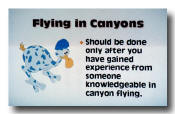
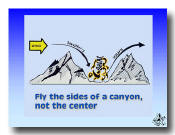 Generally
speaking the best path to fly through a canyon will be on the
updraft side (a narrow canyon is the exception). The canyon may be
more or less level terrain, or it may be sloping terrain.
Generally
speaking the best path to fly through a canyon will be on the
updraft side (a narrow canyon is the exception). The canyon may be
more or less level terrain, or it may be sloping terrain.
The airplane will have to be close to the mountain side to take advantage of the potential orographic lift. Maneuver the airplane to within a couple of hundred yards of the canyon side if lift is desired. Beyond this area the lift is insignificant.
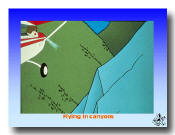 Remember
the basic premises? Always remain in a position to turn to lowering
terrain; and, never fly beyond the point of no return. These two
axioms encompass the idea that you will never enter a canyon if
there is not room to turn around.
Remember
the basic premises? Always remain in a position to turn to lowering
terrain; and, never fly beyond the point of no return. These two
axioms encompass the idea that you will never enter a canyon if
there is not room to turn around.
Only fly in a canyon when there is adequate room to allow a turnaround maneuver. Otherwise, fly the terrain. That is, gain altitude and over-fly the canyon area from the high end to the low end.
It doesn't matter which side you fly down a canyon, either the updraft or downdraft side, because flying downhill makes it easy to transition to either side. Normally we associate updrafts with the sunny side of a mountain, but in canyons it depends on the airflow down a slope more than whether or not the sun is shining on the surface.
The majority of mountain instructors will caution you when flying in canyons to gain sufficient altitude to go to the head of the canyon and then fly downslope terrain. This is sage advice. But, often it is necessary to fly up canyons (fire patrol, game-and-fish surveys, search and rescue, law enforcement).
-
Stay in a position to turn to lowering terrain.
-
Do not fly beyond the point of no return.
Canyon flying can be broken down into four broad classifications; the wide canyon, the narrow canyon and the downslope canyon.
-
Wide Canyon With Level Terrain
This canyon does not pose a problem for flight. Still, to avoid the possibility of shear, the flight path should be along one side of the canyon. How close you fly to the side depends on the circumstances and stability of the air. If you are trying to take advantage of potential lift, whether it is anabatic or mechanical, you will find 500 feet from the canyon side is an acceptable distance. Occasionally, to take advantage of any uplifting air, it will be necessary to move closer to the canyon walls.
-
Wide Canyon With Rising Terrain
There is nothing wrong with flying up canyons ... when you do it properly. In addition to the basic premises (never entering a canyon where there is not room to turn around, be in a position that allows a turnaround if the canyon narrows or if the terrain begins to out climb the airplane), it is a good idea to fly at a speed faster than Vx (best angle-of-climb speed).
If you have ever flown over water beyond the power-off gliding distance from the shore you may have noticed that the engine goes to "automatic rough." You start hearing strange noises that you haven't noticed before and the engine instruments begin jumping around.
A similar thing happens when flying upslope terrain in a canyon. Your left arm becomes shorter and the airspeed may decrease without being noticed. Monitor outside visual references and the flight instruments.
If you can't gain altitude on one side of the canyon, try the other side. Mother Nature may be fooling with you about which side has the updraft.
-
Narrow, Upslope Canyon
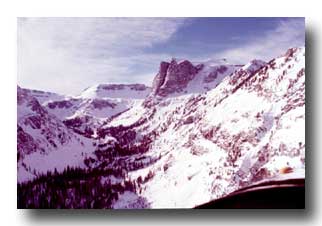 The
first thing we can say about flying up narrow canyons is ... if it's
not done properly, it's not habit forming. Until you become
experienced by receiving flight instruction from a knowledgeable
mountain instructor, stay out of these areas.
The
first thing we can say about flying up narrow canyons is ... if it's
not done properly, it's not habit forming. Until you become
experienced by receiving flight instruction from a knowledgeable
mountain instructor, stay out of these areas.
Speaking of a mountain instructor, do you have to fly with a certified flight instructor to obtain mountain flight instruction? Absolutely not. Many excellent, knowledgeable pilots can provide a wealth of information about mountain flying, but they can't sign your logbook. Do you really care? I don't. I will take learning from whatever source is available.
The narrow canyon is defined as being of a breadth that if a turnaround is required, the airplane will use more than one-half of the canyon width. Radius to turn is defined as being from the center of a circle to the outside edge. This often creates confusion for the novice pilot who thinks he can turn around within the computer value of the radius of turn. The airplane begins its turnaround on the outer edge of a circle. It is necessary to double the value of the radius to determine the width of the turnaround.
When flying within the confines of a narrow canyon, if you approach an area where the terrain out climbs the airplane or the canyon narrows to prevent a turn around maneuver, get out of there and maneuver for additional altitude before proceeding.
For normal flight through a canyon, even one with upslope terrain, the flight is generally made on the side of the updraft. Flying up a narrow canyon is different; it should be accomplished by flying on the downwind side where, if you get into trouble and need to reverse course, your turn will not be into a worse situation. Flying in a narrow canyon along the updraft side will cause the airplane to penetrate the downdraft during a turnaround maneuver.
There is a potential problem in making a turnaround when flying the downdraft side of a narrow canyon. A turn around will expose the airplane to a tailwind that increases the radius of turn. Depending on the wind velocity and stability of the air, if it is necessary to be in the narrow canyon (maybe searching for a downed airplane), it might be wise to gain altitude, fly to the head of the canyon and fly down the canyon.
-
Downslope Canyon
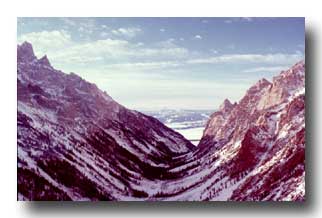 In
most circumstances the downslope canyon can be flown on either the
updraft side or the downdraft side. Since terrain clearance is not a
concern. If you get in a downdraft and feel uncomfortable, move to
the other side.
In
most circumstances the downslope canyon can be flown on either the
updraft side or the downdraft side. Since terrain clearance is not a
concern. If you get in a downdraft and feel uncomfortable, move to
the other side.
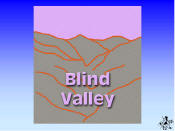 It
is not uncommon when flying in unfamiliar terrain to encounter a
blind canyon. Blind canyons leading to a dead end shouldn't be a
problem, but they are. The reason is that the pilot violates the
basic premises of mountain flying.
It
is not uncommon when flying in unfamiliar terrain to encounter a
blind canyon. Blind canyons leading to a dead end shouldn't be a
problem, but they are. The reason is that the pilot violates the
basic premises of mountain flying.
To avoid potential problems stay out of canyons where there is not room to turn around, remain in a position to turn to lower terrain, and never fly beyond the point-of-no-return.
|
|
|
